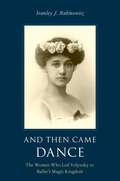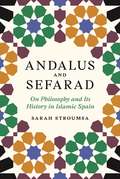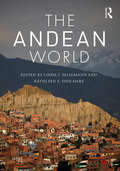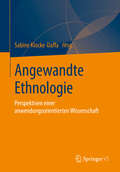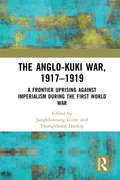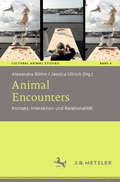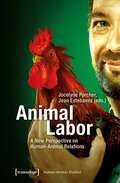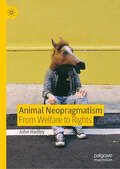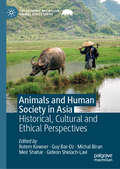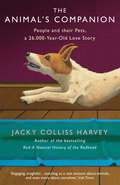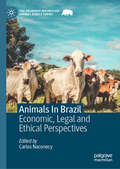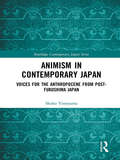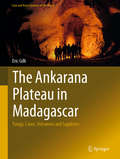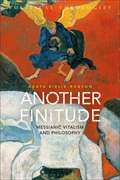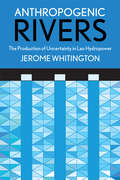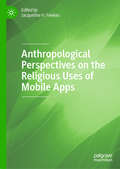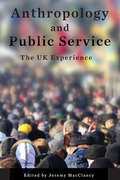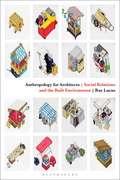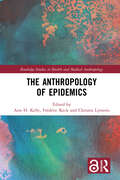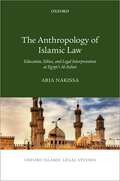- Table View
- List View
AND THEN CAME DANCE C: The Women Who Led Volynsky to Ballet's Magic Kingdom
by Stanley J. RabinowitzPresenting for the first time Akim Volynsky's (1861-1926) pre-balletic writings on Leonardo da Vinci, Fyodor Dostoevsky, Otto Weininger, and on such illustrious personalities as Zinaida Gippius, Ida Rubinstein, and Lou Andreas-Salome, And Then Came Dance provides new insight into the origins of Volynsky's life-altering journey to become Russia's foremost ballet critic. A man for whom the realm of art was largely female in form and whose all-encompassing image of woman constituted the crux of his aesthetic contemplation that crossed over into the personal and libidinal, Volynsky looks ahead to another Petersburg-bred high priest of classical dance, George Balanchine. With an undeniable proclivity toward ballet's female component, Volynsky's dance writings, illuminated by examples of his earlier gendered criticism, invite speculation on how truly ground-breaking and forward-looking this critic is.
Andalus and Sefarad: On Philosophy and Its History in Islamic Spain (Jews, Christians, and Muslims from the Ancient to the Modern World #62)
by Sarah StroumsaAn integrative approach to Jewish and Muslim philosophy in al-AndalusAl-Andalus, the Iberian territory ruled by Islam from the eighth to the fifteenth centuries, was home to a flourishing philosophical culture among Muslims and the Jews who lived in their midst. Andalusians spoke proudly of the region's excellence, and indeed it engendered celebrated thinkers such as Maimonides and Averroes. Sarah Stroumsa offers an integrative new approach to Jewish and Muslim philosophy in al-Andalus, where the cultural commonality of the Islamicate world allowed scholars from diverse religious backgrounds to engage in the same philosophical pursuits.Stroumsa traces the development of philosophy in Muslim Iberia from its introduction to the region to the diverse forms it took over time, from Aristotelianism and Neoplatonism to rational theology and mystical philosophy. She sheds light on the way the politics of the day, including the struggles with the Christians to the north of the peninsula and the Fāṭimids in North Africa, influenced philosophy in al-Andalus yet affected its development among the two religious communities in different ways.While acknowledging the dissimilar social status of Muslims and members of the religious minorities, Andalus and Sefarad highlights the common ground that united philosophers, providing new perspective on the development of philosophy in Islamic Spain.
Andalus and Sefarad: On Philosophy and Its History in Islamic Spain (Jews, Christians, and Muslims from the Ancient to the Modern World #62)
by Sarah StroumsaAn integrative approach to Jewish and Muslim philosophy in al-AndalusAl-Andalus, the Iberian territory ruled by Islam from the eighth to the fifteenth centuries, was home to a flourishing philosophical culture among Muslims and the Jews who lived in their midst. Andalusians spoke proudly of the region's excellence, and indeed it engendered celebrated thinkers such as Maimonides and Averroes. Sarah Stroumsa offers an integrative new approach to Jewish and Muslim philosophy in al-Andalus, where the cultural commonality of the Islamicate world allowed scholars from diverse religious backgrounds to engage in the same philosophical pursuits.Stroumsa traces the development of philosophy in Muslim Iberia from its introduction to the region to the diverse forms it took over time, from Aristotelianism and Neoplatonism to rational theology and mystical philosophy. She sheds light on the way the politics of the day, including the struggles with the Christians to the north of the peninsula and the Fāṭimids in North Africa, influenced philosophy in al-Andalus yet affected its development among the two religious communities in different ways.While acknowledging the dissimilar social status of Muslims and members of the religious minorities, Andalus and Sefarad highlights the common ground that united philosophers, providing new perspective on the development of philosophy in Islamic Spain.
The Andean World (Routledge Worlds)
by Linda J. Seligmann Kathleen S. Fine-DareThis comprehensive reference offers an authoritative overview of Andean lifeways. It provides valuable historical context, and demonstrates the relevance of learning about the Andes in light of contemporary events and debates. The volume covers the ecology and pre-Columbian history of the region, and addresses key themes such as cosmology, aesthetics, gender and household relations, modes of economic production, exchange, and consumption, postcolonial legacies, identities, political organization and movements, and transnational interconnections. With over 40 essays by expert contributors that highlight the breadth and depth of Andean worlds, this is an essential resource for students and scholars alike.
The Andean World (Routledge Worlds)
by Linda J. Seligmann Kathleen S. Fine-DareThis comprehensive reference offers an authoritative overview of Andean lifeways. It provides valuable historical context, and demonstrates the relevance of learning about the Andes in light of contemporary events and debates. The volume covers the ecology and pre-Columbian history of the region, and addresses key themes such as cosmology, aesthetics, gender and household relations, modes of economic production, exchange, and consumption, postcolonial legacies, identities, political organization and movements, and transnational interconnections. With over 40 essays by expert contributors that highlight the breadth and depth of Andean worlds, this is an essential resource for students and scholars alike.
Angewandte Ethnologie: Perspektiven einer anwendungsorientierten Wissenschaft
by Sabine Klocke-DaffaDie Beiträge des Buches leiten umfassend in die Angewandte Ethnologie ein und schlagen damit eine Brücke zwischen Forschung und Anwendung. Mehr als 40 Ethnolog*innen aus über 30 Hochschulen und Forschungseinrichtungen, Museen, Vereinen und freien Berufen stellen Aufgabenfelder und Anwendungsbereiche vor.Der Inhalt · Teil I Anwendungsorientierte Ethnologie: Genese / Aufgabenfelder / Kritik · Ethische Reflexionen · Theorie und Praxis · Methoden und Analyseverfahren· Teil II Themenfelder und Anwendungsbereiche: Entwicklungszusammenarbeit · Bildungsarbeit und Globales Lernen · Frühpädagogik und Schulbildung · Integration / Soziale Arbeit / Flüchtlingshilfe · Interkulturelle Trainings · Journalismus und Medienarbeit · Marketing · Medizinethnologie und Public Health · Museumsarbeit · Organisationsethnologie · Sportethnologie · Tourismus· Teil III Anwendungsorientierte Ethnologie in der Hochschule: Studium und Beruf · Praxis · Bibliotheksarbeit · Modelle Die HerausgeberinPrivatdozentin Dr. Sabine Klocke-Daffa lehrt Ethnologie an der Universität Tübingen.
The Anglo-Kuki War, 1917–1919: A Frontier Uprising against Imperialism during the First World War
by Jangkhomang Guite Thongkholal HaokipThis book explores the Kuki uprising against the British Empire during the First World War in Northeast frontier of India (then Assam-Burma frontier). It underlines how of the three-year war (1917–1919), spanning over 6,000 square miles, is crucial to understanding present-day Northeast India. The essays in the volume examine several aspects of the war, which had far-reaching consequences for the indigenous population as well as for British attitudes and policy towards the region – including military strategy and tactics, violence, politics, identity, institutions, gender, culture, and the frontier dimensions of the First World War itself. The volume also looks at how the conflict affected the larger dynamics of the region within Asia, and its relevance in world politics beyond the Great War. Drawing on archival sources, extensive fieldwork and oral histories, the volume will be a significant contribution to comprehending the complex geopolitics of the region. It will be of great interest to scholars and researchers of South and Southeast Asian Studies, area studies, modern history, military and strategic studies, insurgency and counterinsurgency studies, tribal warfare and politics.
The Anglo-Kuki War, 1917–1919: A Frontier Uprising against Imperialism during the First World War
by Jangkhomang Guite Thongkholal HaokipThis book explores the Kuki uprising against the British Empire during the First World War in Northeast frontier of India (then Assam-Burma frontier). It underlines how of the three-year war (1917–1919), spanning over 6,000 square miles, is crucial to understanding present-day Northeast India. The essays in the volume examine several aspects of the war, which had far-reaching consequences for the indigenous population as well as for British attitudes and policy towards the region – including military strategy and tactics, violence, politics, identity, institutions, gender, culture, and the frontier dimensions of the First World War itself. The volume also looks at how the conflict affected the larger dynamics of the region within Asia, and its relevance in world politics beyond the Great War. Drawing on archival sources, extensive fieldwork and oral histories, the volume will be a significant contribution to comprehending the complex geopolitics of the region. It will be of great interest to scholars and researchers of South and Southeast Asian Studies, area studies, modern history, military and strategic studies, insurgency and counterinsurgency studies, tribal warfare and politics.
Animal Encounters: Kontakt, Interaktion und Relationalität (Cultural Animal Studies #4)
by Alexandra Böhm Jessica UllrichDer Band bestimmt den Begriff der Begegnung als eigene, bedeutungstragende Kategorie und fokussiert zum ersten Mal systematisch und historisch Fragen der Interaktion zwischen Menschen und Tieren in Philosophie, Kunst, Literatur und in sozio-kulturellen Praktiken. Einzelanalysen untersuchen die Formen und Funktionen der Interaktion zwischen unterschiedlichen Spezies sowie deren grundlegende Muster, die einerseits von Empathie, Achtsamkeit oder Agency gekennzeichnet sind, bzw. andererseits von Gewalt, Ausgrenzung, Widerständigkeit oder Konfrontation. Damit ergänzt die Publikation die Erforschung der Tier-Mensch-Beziehung um den zentralen Aspekt von ambivalenten Interspezies-Begegnungen, die zugleich destruktives und transformatives Potential offenbaren.
Animal Labor: A New Perspective on Human-Animal Relations (Human-Animal Studies #18)
by Jocelyne Porcher Jean EstebanezDo animals work? Is it possible to work with animals without exploiting them? Might animals even be empowered through work? This provocative collection offers original answers to these questions and allows readers to think about human relationships with domestic animals beyond the well-trodden tropes of domination or animal welfare. To study animal work means to look at animals in new ways and to discover in them unsuspected skills and knowledge that open up new ethical and political horizons.
Animal Neopragmatism: From Welfare to Rights
by John HadleyThis book affords a neopragmatic theory of animal ethics, taking its lead from American Pragmatism to place language at the centre of philosophical analysis. Following a method traceable to Dewey, Wittgenstein and Rorty, Hadley argues that many enduring puzzles about human interactions with animals can be ‘dissolved’ by understanding why people use terms like dignity, respect, naturalness, and inherent value. Hadley shifts the debate about animal welfare and rights from its current focus upon contentious claims about value and animal mindedness, to the vocabulary people use to express their concern for the suffering and lives of animals. With its emphasis on public concern for animals, animal neopragmatism is a uniquely progressive and democratic theory of animal ethics.
Animals and Human Society in Asia: Historical, Cultural and Ethical Perspectives (The Palgrave Macmillan Animal Ethics Series)
by Rotem Kowner Michal Biran Gideon Shelach-Lavi Meir Shahar Guy Bar-OzThis edited collection offers a comprehensive overview of the different aspects of human-animal interactions in Asia throughout history. With twelve thematically-arranged chapters, this book examines the diverse roles that beasts, livestock, and fish — real and metaphorical– have played in Asian history, society, and culture. Ranging from prehistory to the present day, the authors address a wealth of topics including the domestication of animals, dietary practices and sacrifice, hunting, the use of animals in war, and the representation of animals in literature and art. Providing a unique perspective on human interaction with the environment, the volume is cross-disciplinary in its reach, offering enriching insights to the fields of animal ethics, Asian studies, world history and more.
The Animal's Companion: People and their Pets, a 26,000-Year Love Story
by Jacky Colliss HarveyThe earliest evidence of a human and a pet can be traced as far back as 26,000 BC in France where a boy and his 'canid' took a walk through a cave. Their foot and paw prints were preserved together on the muddy cave floor, and smoke from the torch the boy carried was left on the walls, allowing archaeologists to carbon-date their journey. And so, the story unfolds, from these prehistoric days all the way up to the present, of our innate and undeniable need to live in the close company of animals. In this startling new work, acclaimed cultural detective and lifelong pet owner Jacky Colliss Harvey uses her compelling storytelling skills and keen eye for historical investigation to examine our role as animals' companions, in this exploration of the history not of the pet, but of us as pet owners. Drawing on literary, artistic and archaeological evidence of our relationships with other species, over thousands of years of human experience, she examines the when, the how and the why of our connection to those animals we take into our lives, assessing these against the latest scientific thinking on this complex and enthralling subject, and suggesting new insights into this most long-standing of all human love-affairs.
Animals In Brazil: Economic, Legal and Ethical Perspectives (The Palgrave Macmillan Animal Ethics Series)
by Carlos NaconecyThis book presents a collection of essays exploring the legal, economic, socio-environmental, and ethical dimensions of human-animal interaction in Brazil. As one of the primary global producers and exporters of beef, with a level of biodiversity in its rain-forests found nowhere else under threat, the importance of Brazil for animal life is unquestionable. Shedding light on the profound transformations in the consumption and production of animal-sourced foods that have taken place over the last five decades, the authors examine the consequences of this phenomenon for the lives of animals, the health of the population, and the environment. The book also offers an analysis of the animal welfare and animal protection legislation in Brazil, before presenting a number of notable cases involving animal advocacy and activism in recent years. An important and timely collection, this book concludes with an exploration of the historical, socio-cultural and economic aspects that influence the Brazilian ethos regarding the morality of the treatment of animals.
Animism in Contemporary Japan: Voices for the Anthropocene from post-Fukushima Japan (Routledge Contemporary Japan Series)
by Shoko Yoneyama‘Postmodern animism’ first emerged in grassroots Japan in the aftermath of mercury poisoning in Minamata and the nuclear meltdown in Fukushima. Fusing critiques of modernity with intangible cultural heritages, it represents a philosophy of the life-world, where nature is a manifestation of a dynamic life force where all life is interconnected. This new animism, it is argued, could inspire a fundamental rethink of the human-nature relationship. The book explores this notion of animism through the lens of four prominent figures in Japan: animation film director Miyazaki Hayao, sociologist Tsurumi Kazuko, writer Ishimure Michiko, and Minamata fisherman-philosopher Ogata Masato. Taking a biographical approach, it illustrates how these individuals moved towards the conclusion that animism can help humanity survive modernity. It contributes to the Anthropocene discourse from a transcultural and transdisciplinary perspective, thus addressing themes of nature and spirituality, whilst also engaging with arguments from mainstream social sciences. Presenting a new perspective for a post-anthropocentric paradigm, Animism in Contemporary Japan will be useful to students and scholars of sociology, anthropology, philosophy and Japanese Studies.
Animism in Contemporary Japan: Voices for the Anthropocene from post-Fukushima Japan (Routledge Contemporary Japan Series)
by Shoko Yoneyama‘Postmodern animism’ first emerged in grassroots Japan in the aftermath of mercury poisoning in Minamata and the nuclear meltdown in Fukushima. Fusing critiques of modernity with intangible cultural heritages, it represents a philosophy of the life-world, where nature is a manifestation of a dynamic life force where all life is interconnected. This new animism, it is argued, could inspire a fundamental rethink of the human-nature relationship. The book explores this notion of animism through the lens of four prominent figures in Japan: animation film director Miyazaki Hayao, sociologist Tsurumi Kazuko, writer Ishimure Michiko, and Minamata fisherman-philosopher Ogata Masato. Taking a biographical approach, it illustrates how these individuals moved towards the conclusion that animism can help humanity survive modernity. It contributes to the Anthropocene discourse from a transcultural and transdisciplinary perspective, thus addressing themes of nature and spirituality, whilst also engaging with arguments from mainstream social sciences. Presenting a new perspective for a post-anthropocentric paradigm, Animism in Contemporary Japan will be useful to students and scholars of sociology, anthropology, philosophy and Japanese Studies.
The Ankarana Plateau in Madagascar: Tsingy, Caves, Volcanoes and Sapphires (Cave and Karst Systems of the World)
by Eric GilliThe book describes the Ankarana plateau and its cave network in Madagascar, depicting the natural environment of the Plateau as well as the natural processes which created the cave network of more than 100km with many galleries, some are very large and draped with different cave formations and underground rivers are inhabited with crocodiles and giant eels.This place is famous for its surface landscape formed with tsingy, natural needles formed by the weathering of limestone. The Ankarana is surrounded by native Madagascan rain forest inhabited with lemurs and it was a natural shelter for the Ankarana people whose kings were buried in caves. The cave system has been partially explored since the sixties and exploration is still in progress. The book includes several maps (geology, topography, hydrology), the survey of the caves and a brief description of the Ankarana Kingdom.
Another Finitude: Messianic Vitalism and Philosophy (Political Theologies)
by Agata Bielik-RobsonBeginning from the notion of finite life, Another Finitude takes this staple subject from post-Heideggerian philosophy and opposes it to the onto-theological concept of infinity, represented by an eternal absolute. Although critical of Heidegger and his definition of finitude as 'being-towards-death', this book does not revert to the ontological idea of infinity secured in the sacred image of immortality. But it also does not want to give up on infinity altogether; the infinite is transposed, so it can become a necessary moment of the finite life. A theological framework for the new elaboration of the concept of finitude is crucial; but instead of following the Lutheran formula, Agata Bielik-Robson turns to the sources of Judaism. Taking inspiration from the Jewish idea of torat hayim, the principle of finite life, which found the best expression in the biblical sentence: love strong as death; love emerges as the alternative marker of finitude, allowing to us redefine it in an affirmative way. By tracing the avatars of love in the group of 20th-century thinkers, or 'messianic vitalists'–Benjamin, Rosenzweig, Arendt, Derrida, and (deeply revised) Freud–the book attempts to demonstrate the possibility of such affirmation. Love becomes the new 'infinite-in-the-finite'; love in all its forms, from the original libidinal endowment of the human psyche to the last metamorphoses of agape, the Greco-Christian divine love.
Anthropogenic Rivers: The Production of Uncertainty in Lao Hydropower (Expertise: Cultures and Technologies of Knowledge)
by Jerome WhitingtonIn the 2000s, Laos was treated as a model country for the efficacy of privatized, "sustainable" hydropower projects as viable options for World Bank-led development. By viewing hydropower as a process that creates ecologically uncertain environments, Jerome Whitington reveals how new forms of managerial care have emerged in the context of a privatized dam project successfully targeted by transnational activists. Based on ethnographic work inside the hydropower company, as well as with Laotians affected by the dam, he investigates how managers, technicians and consultants grapple with unfamiliar environmental obligations through new infrastructural configurations, locally-inscribed ethical practices, and forms of flexible experimentation informed by American management theory.Far from the authoritative expertise that characterized classical modernist hydropower, sustainable development in Laos has been characterized by a shift from the risk politics of the 1990s to an ontological politics in which the institutional conditions of infrastructure investment are pervasively undermined by sophisticated ‘hactivism.’ Whitington demonstrates how late industrial environments are infused with uncertainty inherent in the anthropogenic ecologies themselves. Whereas ‘anthropogenic’ usually describes human-induced environmental change, it can also show how new capacities for being human are generated when people live in ecologies shot through with uncertainty. Implementing what Foucault called a "historical ontology of ourselves," Anthropogenic Rivers formulates a new materialist critique of the dirty ecologies of late industrialism by pinpointing the opportunistic, ambitious and speculative ontology of capitalist natures.
Anthropological Perspectives on the Religious Uses of Mobile Apps
by Jacqueline H. FewkesThis edited volume deploys digital ethnography in varied contexts to explore the cultural roles of mobile apps that focus on religious practice and communities, as well as those used for religious purposes (whether or not they were originally developed for that purpose). Combining analyses of local contexts with insights and methods from the global subfield of digital anthropology, the contributors here recognize the complex ways that in-app and on-ground worlds interact in a wide range of communities and traditions. While some of the case studies emphasize the cultural significance of use in local contexts and relationships to pre-existing knowledge networks and/or non-digital relationships of power, others explore the globalizing and democratizing influences of mobile apps as communication technologies. From Catholic confession apps to Jewish Kaddish assistance apps and Muslim halal food apps, readers will see how religious-themed mobile apps create complex sites for potential new forms of religious expression, worship, discussion, and practices.
Anthropology and Public Service: The UK Experience
by Jeremy MacClancyThese days an increasing number of social anthropologists do not find employment within academia. Rather, many find jobs with commercial organizations or in government, where they run research teams and create policy. These scholars provide a much-needed social dimension to government thinking and practice. Anthropology and Public Service shows how anthropologists can set new agendas, and revise old ones in the public sector. Written for scholars and students of various social sciences, these chapters include discussions of anthropologists’ work with the Department for International Development, the Ministry of Defence, the UK Border Agency, and the Cabinet Office, and their contributions to prison governance.
Anthropology for Architects: Social Relations and the Built Environment
by Ray LucasWhat can architects learn from anthropologists? This is the central question examined in Anthropology for Architects – a survey and exploration of the ideas which underpin the correspondence between contemporary social anthropology and architecture. The focus is on architecture as a design practice. Rather than presenting architectural artefacts as objects of the anthropological gaze, the book foregrounds the activities and aims of architects themselves. It looks at the choices that designers have to make – whether engaging with a site context, drawing, modelling, constructing, or making a post-occupancy analysis – and explores how an anthropological view can help inform design decisions. Each chapter is arranged around a familiar building type (including the studio, the home, markets, museums, and sacred spaces), in each case showing how anthropology can help designers to think about the social life of buildings at an appropriate scale: that of the individual life-worlds which make up the everyday lives of a building's users. Showing how anthropology offers an invaluable framework for thinking about complex, messy, real-world situations, the book argues that, ultimately, a truly anthropological architecture offers the potential for a more socially informed, engaged and sensitive architecture which responds more directly to people's needs.Based on the author's experience teaching as well as his research into anthropology by way of creative practice, this book will be directly applicable to students and researchers in architecture, landscape, urban design, and design anthropology, as well as to architectural professionals.
The Anthropology of Epidemics (Routledge Studies in Health and Medical Anthropology)
by Christos Lynteris Ann H. Kelly Édéric KeckOver the past decades, infectious disease epidemics have come to increasingly pose major global health challenges to humanity. The Anthropology of Epidemics approaches epidemics as total social phenomena: processes and events which encompass and exercise a transformational impact on social life whilst at the same time functioning as catalysts of shifts and ruptures as regards human/non-human relations. Bearing a particular mark on subject areas and questions which have recently come to shape developments in anthropological thinking, the volume brings epidemics to the forefront of anthropological debate, as an exemplary arena for social scientific study and analysis.
The Anthropology of Epidemics (Routledge Studies in Health and Medical Anthropology)
by Christos Lynteris Ann H. Kelly Édéric KeckOver the past decades, infectious disease epidemics have come to increasingly pose major global health challenges to humanity. The Anthropology of Epidemics approaches epidemics as total social phenomena: processes and events which encompass and exercise a transformational impact on social life whilst at the same time functioning as catalysts of shifts and ruptures as regards human/non-human relations. Bearing a particular mark on subject areas and questions which have recently come to shape developments in anthropological thinking, the volume brings epidemics to the forefront of anthropological debate, as an exemplary arena for social scientific study and analysis.
The Anthropology of Islamic Law: Education, Ethics, and Legal Interpretation at Egypt's Al-Azhar (Oxford Islamic Legal Studies)
by Aria NakissaThe Anthropology of Islamic Law shows how hermeneutic theory and practice theory can be brought together to analyze cultural, legal, and religious traditions. These ideas are developed through an analysis of the Islamic legal tradition, which examines both Islamic legal doctrine and religious education. The book combines anthropology and Islamicist history, using ethnography and in-depth analysis of Arabic religious texts. The book focuses on higher religious learning in contemporary Egypt, examining its intellectual, ethical, and pedagogical dimensions. Data is drawn from fieldwork inside al-Azhar University, Cairo University's Dar al-Ulum, and the network of traditional study circles associated with the al-Azhar mosque. Together these sites constitute the most important venue for the transmission of religious learning in the contemporary Muslim world. The book gives special attention to contemporary Egypt, and also provides a broader analysis relevant to Islamic legal doctrine and religious education throughout history.
